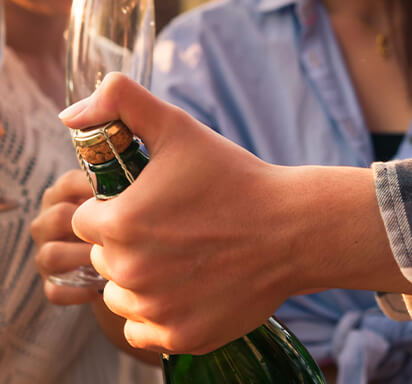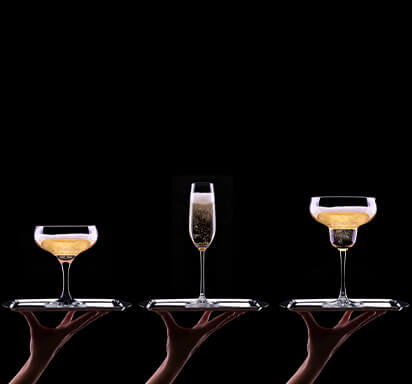Everything you need to know about the Champagne saber

A swift swoop of the knife along the neck of the bottle, followed by a “pop!” as the glass shatters and the “hiss” of the Champagne as it flows out. There is no more festive way of opening a bottle of Champagne than by sabering it
A swift swoop of the knife along the neck of the bottle, followed by a “pop!” as the glass shatters and the “hiss” of the Champagne as it flows out, bubbling… There is no more festive and ceremonial way of opening a bottle of Champagne than by sabering it. And while sabering Champagne can be extremely dangerous when done incorrectly, it is perfectly safe as long as you take certain precautions and follow the rules. Discover our guide to sabering a Champagne bottle!
THE HISTORY OF “SABRAGE”
Before we get into how to saber Champagne, let’s take a look at the history of this festive way of opening a bottle of Champagne. This technique for opening a bottle of bubbly was popularized just after the French Revolution, when Napoleon Bonaparte’s cavalry would visit aristocratic estates around France and celebrate their victories with Champagne. Their weapon of choice was the saber, which they would use to lop off the top of a bottle and consume the wine inside.
Madame Clicquot, matron of the Veuve Clicquot Champagne House, famously entertained Napoleon’s officers at her estate. It is said that as the soldiers rode away, they would saber their Champagne bottles to try to impress her. Eventually, as sparkling wine gained popularity throughout Europe, the tradition of sabering a bottle spread. Today, it remains a well-respected tradition in the sommelier community and is often chosen to celebrate special occasions, like inaugurations.
THE PHYSICS BEHIND SABERING
So how does it work? Champagne is a carbonated wine and a bottle of Champagne contains around 90 PSI of pressure, which is roughly three times the pressure inside of a car tire, for reference. The diameter of the opening into which the cork is lodged is 0.71 inches and the force pushing on the cork is roughly 160 newtons.
A bottle of wine has two “stress concentrations,” which are basically weak points in the glass. The first is located at the lip and the second along the thin, vertical seem running up the side of the bottle. Where these two stress concentrations (the lip and the seam) intersect, the strength of the glass is roughly 50% less. To saber a bottle of Champagne, one must strike the bottle precisely at this intersection point.
Upon impact with the saber, the weak point cracks. A combination of the momentum from the saber motion and the pressure of the bottle causes the crack to spread quickly until the top of the bottle is completely severed. Then, the pressure inside the bottle pushes this severed glass, complete with the cork inside the neck, flying roughly 15-30 feet away from the rest of the bottle.
THE “SABRE À CHAMPAGNE” OR CHAMPAGNE SABERS
What will you need to saber a bottle of Champagne? You will need to choose a bottle from your collection, preferably not an expensive bottle from one of the top Champagne brands, if it’s your first try. You will also need a weapon of your choosing.
The champagne sword (or sabre à Champagne) was specially designed for the act of sabering (or sabrage). One of the best Champagne sabres is the Champagne Saber Fox Sciabola del Sommelier, made in Italy and featuring a stainless steel blade with Sciabola del Sommelier bronze or nickel handle and leather sheath. For large formats, this brand has created the Mathusalem Sciabola del Sommelier with a blade measuring over 13 inches.
Considered a king of Champagne sabre elegance is the Laguiole en Aubrac Champagne Saber, also available with an olive wood handle or ebony wood handle. For a Champagne Sabre with a black handle, choose their Buffalo option. Finally, for a Champagne Saber best, Champagne Saber Berkel has created a wide range of Berkel Champagne swords and Champagne Saber options. Finally, the Morgan King Champagne Saber is perfectly designed to open Champagne bottles by sabrage.
If you do not have a Champagne sword or saber, do not fret. You can use one of a wide range of long, metal tools, as long as it has a blunt edge. These include a chef’s knife, fox knives, a butter knife or a spoon. In fact, some very talented and practiced sommeliers even manage to saber a bottle with the base of a Champagne flute, their mobile phone or a shoe. (We do not recommend trying the latter at home.)
A FEW TIPS BEFORE YOU SABER CHAMPAGNE
So, you’ve got your bottle of Champagne and sword ready and you can’t wait to saber your bottle of sparkling wine. Great! Before we go into the steps of sabering the bottle, we do have some general tips to consider.
• Make sure your bottle is chilled. We recommend chilling a bottle of Champagne to 38-42 degrees Fahrenheit before attempting to saber it. This is because the colder the bottle, the more brittle the glass and the easier it will crack on impact. A colder bottle will also have less pressure built-up than a room-temperature bottle, which will make the former safer to saber.
• Make sure your environment allows for safe sabering. As with anything involving an upbuild of pressure and sudden release of kinetic energy, sabering can be quite dangerous when done under the wrong conditions. To allow for safe sabering, make sure you are outdoors in an open space. Take care to orient the bottle away from any people, buildings or objects of value. For added safety, we recommend using protective eyewear while sabering the bottle.
• Practice the swing movement a few times. As with everything, practice makes perfect when it comes to sabering Champagne. Make sure to practice the swing motion a few times in order to get comfortable with this movement. This will help ensure a successful saber.
HOW TO SABRE A BOTTLE OF CHAMPAGNE IN 7 SIMPLE STEPS
Are you ready to try sabering a bottle of Champagne? Fantastic! Follow our simple steps below.
1. Remove the foil and wire cage.
First, use a knife or wine key to slice the foil completely off the neck of the bottle. Holding the bottle at a 45° angle push the top of the wire cage down as you twist the cage tab counterclockwise (6 half-twists should do). Loosen the cage around the bottle neck and remove it only when you are ready to saber. Keep your thumb on the top of the cork until this moment, to prevent the cork from flying out prematurely.
2. Cradle the bottle and prepare for sabering.
Cradle the bottle at the level of your waist using your less-dominant hand (so left hand if you’re right-handed or right hand if you’re a leftie). Point the bottle at a 45° angle and away from yourself or anyone/anything present.
3. Run the blunt side of your knife along the seam.
Holding your knife or saber in your dominant hand, run the blunt edge of the blade along the seam running up vertically along the side of your bottle. The seam should be facing you during the process, as should the sharp edge of the blade. Try moving the blade without hitting any part of the bottle to get a feel for it.
4. Strike the point where the seam meets the lower lip of the bottle.
In one swift motion, run your knife or saber along the vertical seam on the side of the bottle, striking the spot where the seam meets the lower lip towards the top of the neck. The top of the bottle neck should break away in one clean motion and be pushed forward by the pressure inside the bottle.
5. Allow the Champagne to flow for a few seconds.
After the top of the bottle neck breaks off, make sure to allow the Champagne to flow for a few seconds to ensure that any potential glass shards are washed out of the neck of the bottle before you serve the wine. This step may seem counterintuitive as it seems like wasting more Champagne than necessary. However, it is crucial to ensure the safety of your guests.
6. Serve yourself a glass and check for shards.
Before serving your guests, pour yourself a glass of Champagne and check to make sure there are no shards of glass floating on the surface. If you have any hesitation, discard the glass and bottle immediately without serving.
7. Clean up.
After your guests have been served, take a moment to pick up the cork, along with any shattered glass that may have been released during the sabrage. These sharp shards have the potential to harm, so make sure to dispose of them safely before settling down to enjoy your glass of bubbly.
THE DANGERS OF THE CHAMPAGNE SABRE
Sabering a bottle of Champagne can be a joyful and festive spectacle with the potential to make any moment truly unforgettable. However, it can also be extremely dangerous when done incorrectly. The bottle can explode and glass shards can go flying, harming the “saberer” and/or spectators. The bottle may drop to the ground and shatter, sending glass flying everywhere. Shards of glass may fall unnoticeably into the bottle neck and be unwittingly served to guests.
Before attempting a Champagne saber, make sure that you have had enough practice, that you understand the risks and that you (and the people around you) are 100% comfortable with the process. If all these conditions are met and you have studied our 7-step guide, you should be ready to go. Happy sabering!
Ready to saber your first bottle of Champagne? Or maybe you’re just looking for the perfect bottle to open (in the more conventional way) on a special occasion. Or maybe you’re asking yourself “Where can I find champagnes near me?” Take a moment to browse our extensive selection of Champagnes or reach out to our team of experts directly for guidance on anything Champagne or wine related!
You may like
Unveil the unique characteristics of Champagne Blanc de Blancs and Blanc de Noirs. Learn how these two styles differ in flavor, grape varieties, and food pairings to elevate your Champagne experience.
12/19/2024Discover how Chardonnay, Pinot Noir, and Pinot Meunier shape the distinct character of Champagne. Learn about rare grape varieties and explore notable examples from top producers in the world’s most famous sparkling wine region.
7/4/2024To help you safely open a bottle of bubbly, we have put together a guide with 6 simple steps. Learn more about when to open a bottle of Champagne and how to do it in the safest and most graceful way.
3/11/2023Guardian of the bottle and the precious bubbly inside, the cork serves an essential role in the preservation of Champagne. Over the years, it has evolved and adapted to this very special role.
3/6/2023What is the best way to store Champagne or sparkling wine for the short or long term? Find here best storage practices, which will help keep your bottle of bubbly Champagne or sparkling wines fresh for as long as possible.
2/20/2023There is something truly special about opening a bottle of Champagne or sparkling wine. But have you ever wondered what sets apart Champagne from sparkling wineslike Prosecco, Cava and Lambrusco?
2/20/2023
















